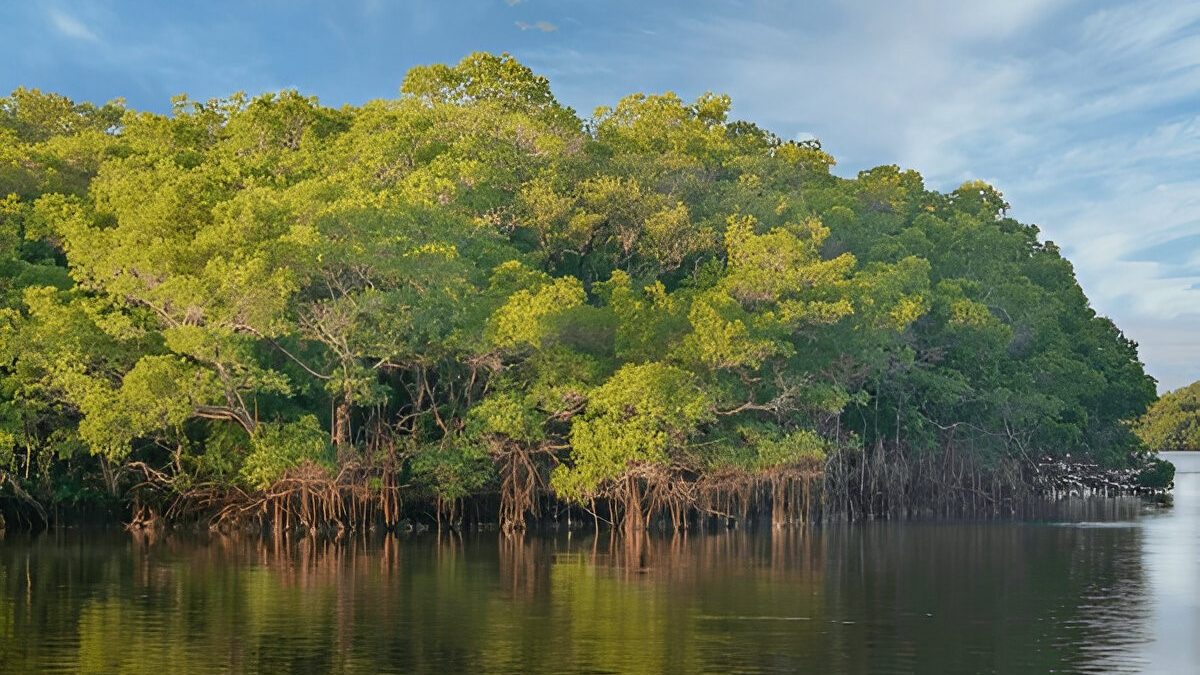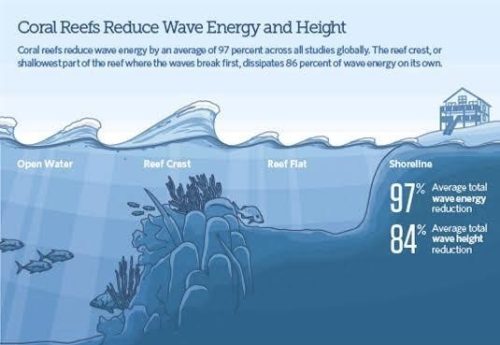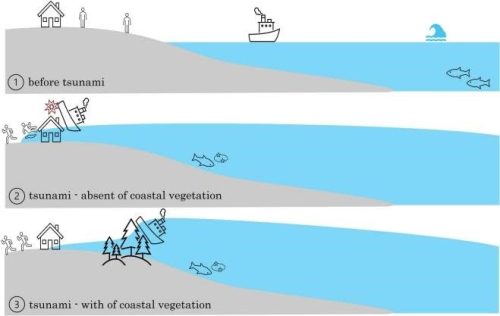Coastal Ecosystems: Nature’s Guardians of Resilience and Prosperity

A mangrove coast (Photo Credit : Donna Bollenbach)
Coastal ecosystems, such as mangroves, coral reefs, seagrasses, and salt marshes, play a crucial role in ensuring the physical, ecological, and economic stability of coastal regions. These natural systems act as powerful buffers against natural disasters, hubs of biodiversity, and drivers of local economies, making their conservation critical for sustainable development.
These ecosystems not only serve as homes and shelters for countless marine species, offering safe places to breed and feed, but also for the safety and prosperity of human communities. Their role as protective barriers and natural regulators highlights the close relationship between a thriving environment and resilient societies.
Physical Protection: Shields Against Powerful Forces of Nature
Coastal ecosystems serve as natural barriers that protect shorelines from the relentless forces of waves, storm surges, and tsunamis. These ecosystems absorb and dissipate the energy from these forces, significantly reducing their impact on coastal communities and infrastructure.
- Mangroves are particularly effective at dissipating wave energy. Their dense root network slow down waves as they approach the shore, reducing their height and energy by as much as 90% in some cases (MIT Climate Portal, 2021).

Diagram illustrating coastal protection by mangroves (Photo Credit : Gijón, et al.)
- Coral reefs, which act as underwater barriers, break waves offshore, preventing them from directly crashing into the coastline. This reduces abrasion and minimizes damage during storms.

Diagram illustrating coastline protection by coral reefs (Photo Credit : Ferrario, et al.)
- Coastal vegetation can mitigate the impact of tsunamis. Their layered structure, thick roots, and dense foliage, slows down the advancing waves and reduce their destructive energy.

Diagram illustrating mitigation the impact of tsunami by coastal vegetation (Photo Credit : Benazir, et al.)
Ecological Richness: Cradles of Coastal Biodiversity
Indonesia's coastal ecosystems stand among the most biodiverse in the world, serving as vital habitats for countless marine and terrestrial species while supporting the livelihoods of millions of Indonesians. With 12 of the world’s 69 seagrass species, Indonesia is a global hotspot for these critical ecosystems. Seagrass meadows provide essential food and shelter for thousands of marine species, including fish, seahorses, and turtles, and underpin some of the largest fisheries globally. These ecosystems also play a crucial role in improving water quality by filtering, cycling, and storing nutrients and pollutants, reducing contamination in seafood (UN, 2024).
Indonesia is also home to the largest coral reef area in Southeast Asia, estimated at approximately 51,000 km². These reefs are among the most biologically rich in the world, hosting over 590 identified coral species—around 75% of the global total. Raja Ampat, in particular, boasts an extraordinary diversity of marine life, with at least 553 species of Scleractinia corals and over 1,320 species of reef fish, marking it as one of the most species-rich coral reef systems on Earth (State of the Coral Triangle, 2014).
Indonesia's coastal ecosystems not only embody extraordinary ecological richness but also represent a critical foundation for sustainable development and global biodiversity conservation. About 5% of the reefs were in excellent condition, 25% in good condition, 37% in moderate condition, and 32% in bad condition.
Economic Drivers: Sustaining Livelihoods and Communities
Coastal ecosystems offer far-reaching economic benefits that extend beyond their environmental functions, playing a crucial role in sustaining local and global economies. Healthy coral reefs and mangrove forests support fisheries that provide food, income, and employment for millions of people worldwide. These ecosystems are particularly vital for coastal communities who rely on fishing as their primary livelihood, contributing to the global supply of seafood and supporting related industries.
In addition to fisheries, coastal ecosystems are major drivers of tourism, attracting millions of visitors annually. Beaches, coral reefs, and mangrove forests offer opportunities for ecotourism and recreational activities, generating significant revenue for local economies. Eco-friendly tourism, which emphasizes conservation and sustainable practices, has become increasingly popular, creating new markets for travel, accommodation, and local services.
Nature-based solutions (NBS), such as ecosystem restoration and the preservation of coastal habitats, offer cost-effective and sustainable alternatives to traditional infrastructure. By restoring mangroves, seagrasses, and coral reefs, NBS help mitigate the impacts of climate change, such as coastal erosion and storm surges, while also enhancing biodiversity. These initiatives not only protect vital ecosystems but also create new job opportunities in conservation, restoration, and sustainable tourism, fostering economic growth in coastal communities.
Conclusion
Conserving coastal ecosystems is a multifaceted solution to global challenges. By preserving their physical, ecological, and economic benefits, we ensure resilient coasts that support both nature and humanity. Sustainable management and restoration of these ecosystems are crucial not only for safeguarding biodiversity but also for strengthening the resilience of communities to the impacts of climate change. Investing in the health of our coastal ecosystems is an investment in the future of both the environment and human well-being.
References
Benazir, Radianta Triatmadja, Syamsidik, Nizam, Warniyati, Vegetation-based approached for tsunami risk reduction: Insights and challenges, Progress in Disaster Science, Volume 23, 2024, 100352, ISSN 2590-0617, https://doi.org/10.1016/j.pdisas.2024.100352
Ferrario, F, M.W. Beck, C.D. Storlazzi, F, Micheli, C.C. Shepard, L. Airoldi. 2014. The Effectweness of Coral Reefs for Coastal Hazard Risk: Reduct lon and Adaptation. Noture Communications. Dot:10.1038/ncomms4794 © 2014 The Pew Chartable Trusts
Gijón Mancheño, A.; Herman, P.M.J.; Jonkman, S.N.; Kazi, S.; Urrutia, I.; van Ledden, M. Mapping Mangrove Opportunities with Open Access Data: A Case Study for Bangladesh. Sustainability 2021, 13, 8212. https://doi.org/10.3390/su13158212
MIT Climate Portal. "Coastal Ecosystems and Climate Change." https://climate.mit.edu/explainers/coastal-ecosystems-and-climate-change
The Natural Capital Project. "Strong Coasts: Reducing Climate Risks with Nature-Based Solutions." https://naturalcapitalproject.stanford.edu/research/projects/strong-coasts-reducing-climate-risks-equitable-nature-based-solutions
United Nations. Healthy Seagrass, Healthy Planet. https://indonesia.un.org/en/261632-world-seagrass-day-1-march
State of The Coral Triangle. ADB, 2014.

